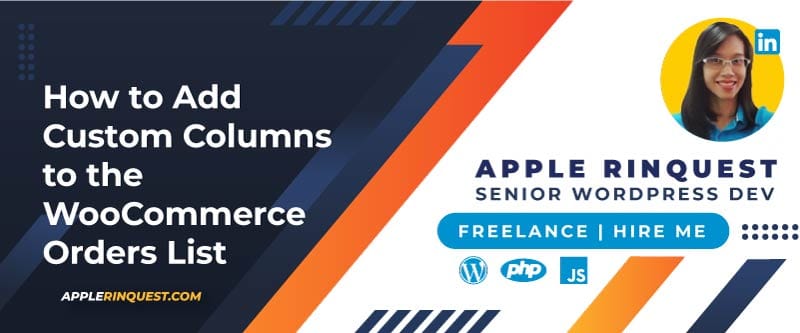Your support helps keep this blog running! Secure payments via Paypal and Stripe.
A Quick Edit is one of the useful features of WordPress: it allows you to make small changes to posts or pages without loading the full editor. By default, Quick Edit lets you change the title, slug, date, password, status, categories, tags, comments/pings, and sticky-flag.

But what if you have your own custom fields (post meta) and you want them to be editable from Quick Edit? Here’s how.
Add Custom Fields (skip this step if you already defined the custom fields)
I have the custom fields for my project post type. If you want to use the same custom fields and project post type as mine, you can download my plugin below and activate it in your WordPress site.
Please complete the form. Upon successful submission, the file download will begin automatically. Please allow a few seconds for the submission to complete.
The screenshot is my custom fields for the project post type, which are project image, description, time spent, website, and published date. The custom post type is called mms_project_cpt, with custom fields _proj_image, _proj_website, _proj_published_date. You can adapt to your post type and field keys.

Step 1: Add a custom column on the posts/CPT management page
- We will create our own plugin for this tutorial. First, we create a new quick_edit_box folder under the WordPress plugins folder.
- Next, we create a new quick_edit_box.php under the quick_edit_box folder. The quick_edit_box.php is our main plugin file for our plugin.
- Add the code below to the quick_edit_box.php.
<?php
/*
Plugin Name: Add Custom Fields To Quick Edit Box
Plugin URI: https://applerinquest.com/how-to-add-custom-fields-to-your-wordpress/
Description: Add custom fields of the project post type to quick edit box
Version: 1.0.0
Author: Apple Rinquest
Author URI: https://applerinquest.com/
Text Domain: your-textdomain
*/
if (!defined('ABSPATH')) exit; // Exit if accessed directly- Now, we will add some custom fields we want to display on the posts management page. I will add the project image, website, and published date.
- To do that, add the code below to the quick_edit_box.php.
/**
* Add custom fields to the posts management page
*/
if (!function_exists('wpar_add_new_columns')) {
function wpar_add_new_columns($columns)
{
$new_columns = array(
'_proj-image' => esc_html__('Image', 'your-textdomain'),
'_proj-website' => esc_html__('Website', 'your-textdomain'),
'_proj-published' => esc_html__('Published Date', 'your-textdomain'),
);
// return the columns array back
return array_merge($columns, $new_columns);
}
// https://developer.wordpress.org/reference/hooks/manage_post_type_posts_columns/
// manage_{$post_type}_posts_columns action hook
// $post_type is a post type key in the register_post_type().
// I have mms_project_cpt as my projectd post type.
add_filter('manage_mms_project_cpt_posts_columns', 'wpar_add_new_columns');
}
Important: Do not remove the title column — the Quick Edit interface hooks into that column.
We use the manage_{$post_type}_posts_columns filter hook for adding the custom fields to the default columns array. This filter hook will hook the new columns to our project post type only. Now, our custom fields should show on the posts management page.
Related filter and action hooks
- manage_posts_columns filter hook: To add or remove a custom column for posts.
- manage_pages_columns filter hook: To add or remove a custom column for pages.
- manage_{$post_type}_posts_columns filter hook: To add or remove a custom column for specific custom post types.
- manage_pages_custom_column action hook: To add or remove a custom column for the page post type.
- manage_posts_custom_column action hook: To add or remove a custom column for posts, pages, and custom post types.
- Built-in column types in WordPress: checkbox for bulk actions(cb), title, author, categories, tags, comments, and date.
Step 2: Populate the custom‐column values
Next, populate the column with the meta values. To do that, add the code below to the quick_edit_box.php
/**
* Populate custom field value
*/
if (!function_exists('wpar_custom_columns')) {
function wpar_custom_columns($column, $post_id)
{
switch ($column) {
case '_proj-image':
$proj_image = get_post_meta($post_id, '_proj-image', true);
echo '<img src="' . esc_html__($proj_image) . '" alt="" style="width: 200px;">';
break;
case '_proj-website':
$proj_website = get_post_meta($post_id, '_proj-website', true);
echo '<a href="' . esc_url($proj_website) . '" target="_blank">' . esc_url($proj_website) . '</a>';
break;
case '_proj-published':
$proj_published = get_post_meta($post_id, '_proj-published', true);
echo esc_html__($proj_published);
break;
default:
break;
}
}
// https://codex.wordpress.org/Plugin_API/Action_Reference/manage_$post_type_posts_custom_column
add_action('manage_mms_project_cpt_posts_custom_column', 'wpar_custom_columns', 10, 2);
}We use the manage_{$post_type}_posts_custom_column action hook for our project post type. We also use the get_post_meta() for getting the data from the wp_postmeta table, which is a WordPress table that stores the custom fields data.

Step 3: Add custom inputs to the Quick Edit box
Now we hook into the Quick Edit screen. Use quick_edit_custom_box action hook and (for Bulk Edit) optionally bulk_edit_custom_box for adding the custom field into the quick edit box.
Important
The quick_edit_custom_box action hook fires once for each column.
Note that the quick_edit_custom_box action hook won’t fire unless the custom fields are added to the posts management page, which is step 1.
Update note
In newer WP admin lists some themes/plugins override list table markup, so ensure your fieldset uses class inline-edit-col-left / inline-edit-col-right or inline-edit-col-center consistently.
In the quick edit box, I will add the project website field only. To do that, add the code below to the quick_edit_box.php
/**
* Add custom fields to the quick edit box
*
* quick_edit_custom_box allows to add HTML in Quick Edit
*/
if (!function_exists('wpar_add_quick_edit')) {
// $column_name stores only the custom fields
function wpar_add_quick_edit($column_name, $post_type)
{
if (!($column_name === '_proj-website')) return;
// # Note
// The class names that use with fieldset tag,
// it can be inline-edit-col-left, inline-edit-col-center and inline-edit-col-right.
//
// # Trick: You can use the inspection tool from your browser to see what classes the admin page uses in the quick edit box.
?>
<?php
switch ($column_name) {
case '_proj-website':
// We keeps all our custom fields inside the <fieldset>
// # a first column then print out the fieldset tag here.
echo '<fieldset class="inline-edit-col-right" style="border: 1px solid #dddddd;">
<legend style="font-weight: bold; margin-left: 10px;">Project Custom Fields:</legend>
<div class="inline-edit-col">';
// # note that, wp_nonce_field() must add it here at the first custom column. DO NOT add outside the switch().
// Otherwise wp_nonce_field() will render every time that quick_edit_custom_box action hook is called for each column.
wp_nonce_field('wpar_q_edit_nonce', 'wpar_nonce');
echo '<label class="alignleft" style="width: 100%;">
<span class="title">' . __('Website', 'your-textdomain') . '</span>
<span class="input-text-wrap"><input type="url" name="' . $column_name . '" value="" style="width: 100%;"></span>
<span style="font-style: italic;color:#999999; text-align:right; display: inherit;">Enter the website URL</span>
</label>';
echo '<br><br>';
// # a last column then print out the end tags of fieldset here.
echo '</div></fieldset>';
break;
default:
break;
}
}
// https://codex.wordpress.org/Plugin_API/Action_Reference/quick_edit_custom_box
add_action('quick_edit_custom_box', 'wpar_add_quick_edit', 10, 2);
}
Now, no data from the project website field is displayed in the quick edit box yet. Next step, we save the data from the quick edit box and populate the data via JavaScript.
Step 4: Save the Custom Field value from the Quick Edit box
In order to save the changes for the custom fields from the quick edit box, we will use the save_post_{$post_type} action hook. This action hook will apply to our project post type only.
To save the custom field value, add the code below to the quick_edit_box.php.
/**
* Save the custom field value from the quick edit box
*/
if (!function_exists(('wpar_quick_edit_save'))) {
function wpar_quick_edit_save($post_id)
{
// # For quick edits use $_POST for storing the data.
// If it is autosave, we don't do anything.
if (defined('DOING_AUTOSAVE') && DOING_AUTOSAVE)
return $post_id;
// check user capabilities
if (
!current_user_can('edit_post', $post_id)
) {
return;
}
// check nonce
if (
!wp_verify_nonce($_POST['wpar_nonce'], 'wpar_q_edit_nonce')
) {
return;
}
// update the website
if (
isset($_POST['_proj-website'])
) {
update_post_meta($post_id, '_proj-website', $_POST['_proj-website']);
}
}
// https://developer.wordpress.org/reference/hooks/save_post_post-post_type/
add_action('save_post_mms_project_cpt', 'wpar_quick_edit_save');
}Now, after changing the website value from the quick edit box and hitting the Update button. Your new website URL should be saved in the database.
Step 5: Populate the Quick Edit / Bulk inputs with existing meta values
In this step, we will use jQuery to help us. The concept is the same as the inline editor implementation by jQuery. It is simple if you know how to customize the jQuery or JavaScript.
Data Table Structure

From the image above, I use the inspection tool from the browser (F12 for Windows). You will see all posts are rendered inside the <tbody> along with the “the-list” id.
Then each post is rendered on each <tr> along with “post-176” id, where 176 is my post ID. Your post ID will be different from mine.

What idea will we do
What we will do we will use jQuery to find the website field from the hidden <tr id=”post-176″>. Once we find the website field, we will get its value. Then we will find the website input field from the <tr id=”edit-176″>, which is the quick edit box. Once we find the website input field, we will assign the value that we get from the hidden row to the input field.
Add the JS code
Now, add the code below to the quick_edit_box.php
<?php
/**
* Populate the custom field values at the quick edit box using Javascript
*/
if (!function_exists('wpar_quick_edit_js')) {
function wpar_quick_edit_js()
{
// # check the current screen
// https://developer.wordpress.org/reference/functions/get_current_screen/
$current_screen = get_current_screen();
/*
* ****************************************
* # List of default screen ID in WordPress
* ****************************************
PAGE $SCREEN_ID FILE
----------------- ------------------- -----------------------
Media Library upload upload.php
Comments edit-comments edit-comments.php
Tags edit-post_tag edit-tags.php
Plugins plugins plugins.php
Links link-manager link-manager.php
Users users users.php
Posts edit-post edit.php
Pages edit-page edit.php
Edit Site: Themes site-themes-network network/site-themes.php
Themes themes-network network/themes
Users users-network network/users
Edit Site: Users site-users-network network/site-users
Sites sites-network network/sites
If you use the custom post type just like me, you can print out the get_current_screen() object
for checking what screen ID do you need for the next checking.
My current screen ID of project post type is "edit-mms_project_cpt".
var_dump($current_screen);
exit;
*/
if ($current_screen->id != 'edit-mms_project_cpt' || $current_screen->post_type !== 'mms_project_cpt')
return;
// # Make sure jQuery library is loaded because we will use jQuery for populate our custom field value.
wp_enqueue_script('jquery');
?>
<!-- add JS script -->
<script type="text/javascript">
jQuery(function($) {
// we create a copy of the WP inline edit post function
var $wpar_inline_editor = inlineEditPost.edit;
// Note: Hooking inlineEditPost.edit must be done in a JS script, loaded after wp-admin/js/inline-edit-post.js
// then we overwrite the inlineEditPost.edit function with our own code
inlineEditPost.edit = function(id) {
// call the original WP edit function
$wpar_inline_editor.apply(this, arguments);
// ### start: add our custom functionality below ###
// get the post ID
var $post_id = 0;
if (typeof(id) == 'object') {
$post_id = parseInt(this.getId(id));
}
// if we have our post
if ($post_id != 0) {
// tips: use the inspecttion tool to help you see the HTML structure on the edit page.
// explanation:
// On the posts management page, all posts will render inside the <tbody> along with "the-list" id.
// Then each post will render on each <tr> along with "post-176" which 176 is my post ID. Your will be difference.
// When the quick edit menu is clicked on the "post-176", the <tr> will be set as hide(display:none)
// and the new <tr> along with "edit-176" id will be appended after <tr> which is hidden.
// What we will do, we will use the jQuery to find the website value from the hidden <tr>.
// Get that value and assign to the website input field on the quick edit box.
//
// The concept is the same when you create the inline editor by jQuery manually.
// define the edit row
var $edit_row = $('#edit-' + $post_id);
var $post_row = $('#post-' + $post_id);
// get the data
var $website = $('.column-_proj-website', $post_row).text();
// populate the data
$(':input[name="_proj-website"]', $edit_row).val($website);
}
// ### end: add our custom functionality below ###
}
});
</script>
<?php
}
// https://developer.wordpress.org/reference/hooks/admin_print_footer_scripts-hook_suffix/
add_action('admin_print_footer_scripts-edit.php', 'wpar_quick_edit_js');
}Now, the custom field value should show in the quick edit box.
Download the Full Source Code plugin for the Quick Edit box tutorial
Please complete the form. Upon successful submission, the file download will begin automatically. Please allow a few seconds for the submission to complete.
And that’s it for today — you are now able to add custom fields to the Quick Edit interface in WordPress. As always: test in a staging environment, back up your site, and adjust field keys/post-type slugs to your context.
Your support helps keep this blog running! Secure payments via Paypal and Stripe.









